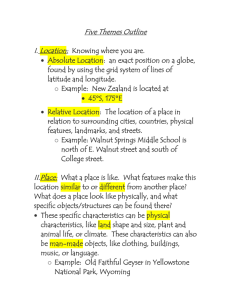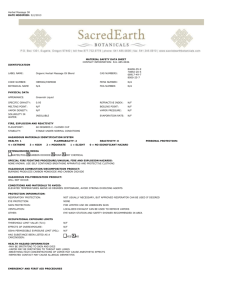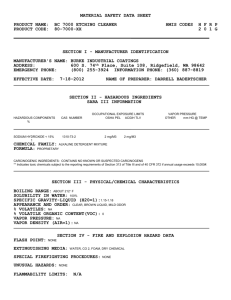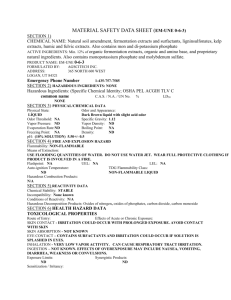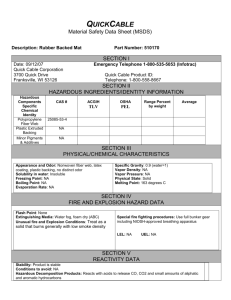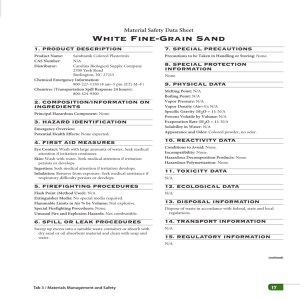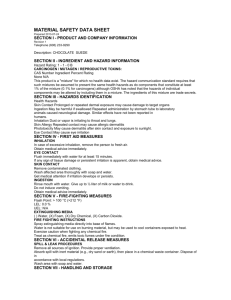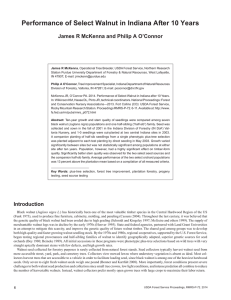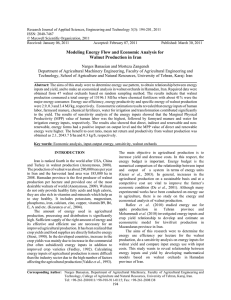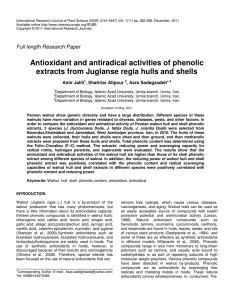Material Safety Data Sheet
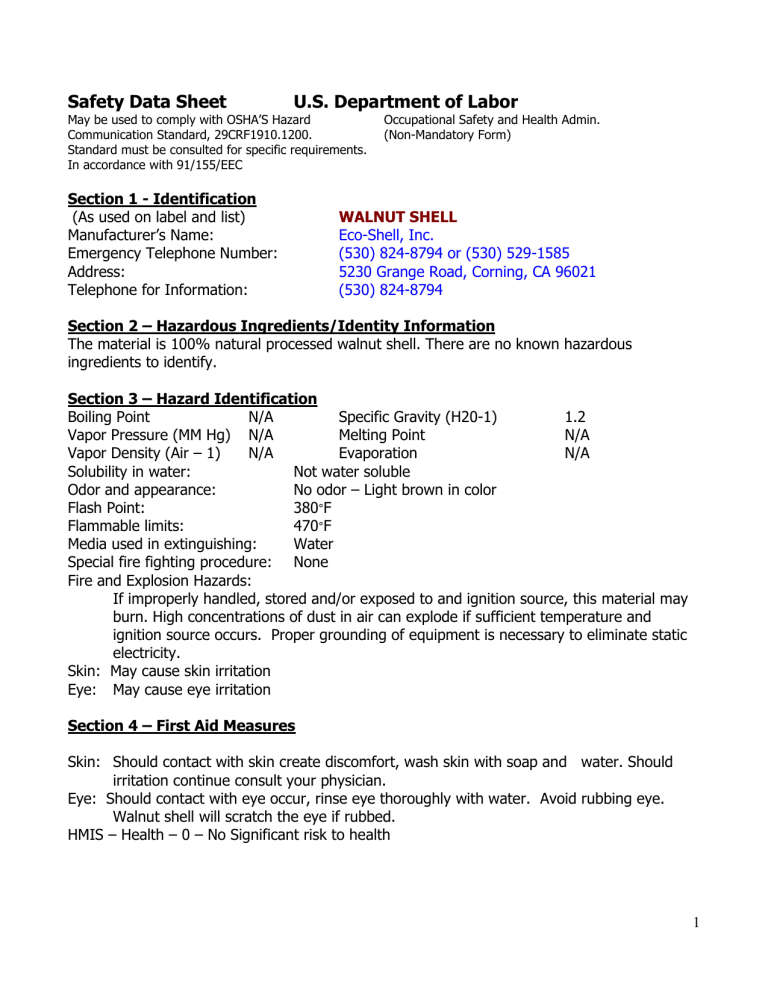
Safety Data Sheet U.S. Department of Labor
May be used to comply with OSHA’S Hazard
Communication Standard, 29CRF1910.1200.
Occupational Safety and Health Admin.
(Non-Mandatory Form)
Standard must be consulted for specific requirements.
In accordance with 91/155/EEC
Section 1 - Identification
(As used on label and list)
Manufacturer’s Name:
Emergency Telephone Number:
Address:
Telephone for Information:
WALNUT SHELL
Eco-Shell, Inc.
(530) 824-8794 or (530) 529-1585
5230 Grange Road, Corning, CA 96021
(530) 824-8794
Section 2 – Hazardous Ingredients/Identity Information
The material is 100% natural processed walnut shell. There are no known hazardous ingredients to identify.
Section 3 – Hazard Identification
Boiling Point N/A
Vapor Pressure (MM Hg) N/A
Vapor Density (Air – 1) N/A
Solubility in water:
Odor and appearance:
Flash Point:
Flammable limits:
Media used in extinguishing:
470
°
F
Water
Special fire fighting procedure: None
Specific Gravity (H20-1)
Melting Point
Evaporation
Not water soluble
No odor – Light brown in color
380
°
F
1.2
N/A
N/A
Fire and Explosion Hazards:
If improperly handled, stored and/or exposed to and ignition source, this material may burn. High concentrations of dust in air can explode if sufficient temperature and ignition source occurs. Proper grounding of equipment is necessary to eliminate static electricity.
Skin: May cause skin irritation
Eye: May cause eye irritation
Section 4 – First Aid Measures
Skin: Should contact with skin create discomfort, wash skin with soap and water. Should irritation continue consult your physician.
Eye: Should contact with eye occur, rinse eye thoroughly with water. Avoid rubbing eye.
Walnut shell will scratch the eye if rubbed.
HMIS – Health – 0 – No Significant risk to health
1
Section 5 – Fire Fighting Measures
Extinguishing Media – Water
No special risks involved
Section 6 – Accidental Release Measures
Steps to be taken if material is released or spilled: Sweep, Shovel up, or Vacuum
Waste Disposal Methods: No special requirements
Section 7 – Handling and Storage
Precautions to be taken in handling and storing: Best if stored in dry conditions. Store away from sources of ignition.
Other Precautions: None
Section 8 – Exposure Controls / Personal Protection
Ventilation: Local Exhaust Nuisance Dust Levels
Protective clothing, gloves, or equipment: Not required
Not required – Safety goggles recommended Eye Protection:
Section 9 – Physical and Chemical Properties
Boiling Point
Specific Gravity (H20-1)
Vapor Pressure (MM Hg)
Melting Point
Vapor Density (Air – 1)
Evaporation
Solubility in water:
Odor and appearance:
Flash Point:
N/A
1.2
N/A
N/A
N/A
N/A
Not water soluble
No odor – Light brown in color
Flammable limits:
HMIS p
H value at 25ºC (in water)
380
°
F
470
°
F
1
4-6
Free Moisture (80ºC FOR 15HRS) 3-9%
Hardness – Vickers No. 25-30
MOHS SCALE 3-4
Elastic Modulus (MOE) 22,900 (9/7/06 test)
Dry Packing Density (LBS PER CU. FT.) 30-50
2
Section 10 – Stability and Reactivity
Stability:
Incompatibility (Materials to avoid)
Stable
None
None Hazardous Polymerization:
HMIS - 0
Section 11 – Toxicological Information
Skin contact may cause rash.
Walnut Shell may contain trace amounts of walnut proteins that have been known to cause allergic reaction
Section 12 – Ecological Information
Biological Degradability: very slow if exposed to moisture and other organic materials.
No known acute toxicity in water, waste water, or soil
Section 13 – Disposal Considerations
Steps to be taken if material is released or spilled: Sweep, Shovel up, or Vacuum
Waste Disposal Methods: No special requirements
Section 14 – Transport Information
No known restrictions
Section 15 – Regulatory Information
No known regulations specific to walnut shell
Section 16 – Other Information
Walnut shells are a natural renewable resource. There are no known hazardous ingredients to identify.
Hazardous Materials Identification System (HMIS)
Health – 0
Flammability – 1
Reactivity (Physical Hazard) – 0
Personal Protection: safety glasses and dust respirator recommended
14 April 2020 Last revised 6/1/2015
3

